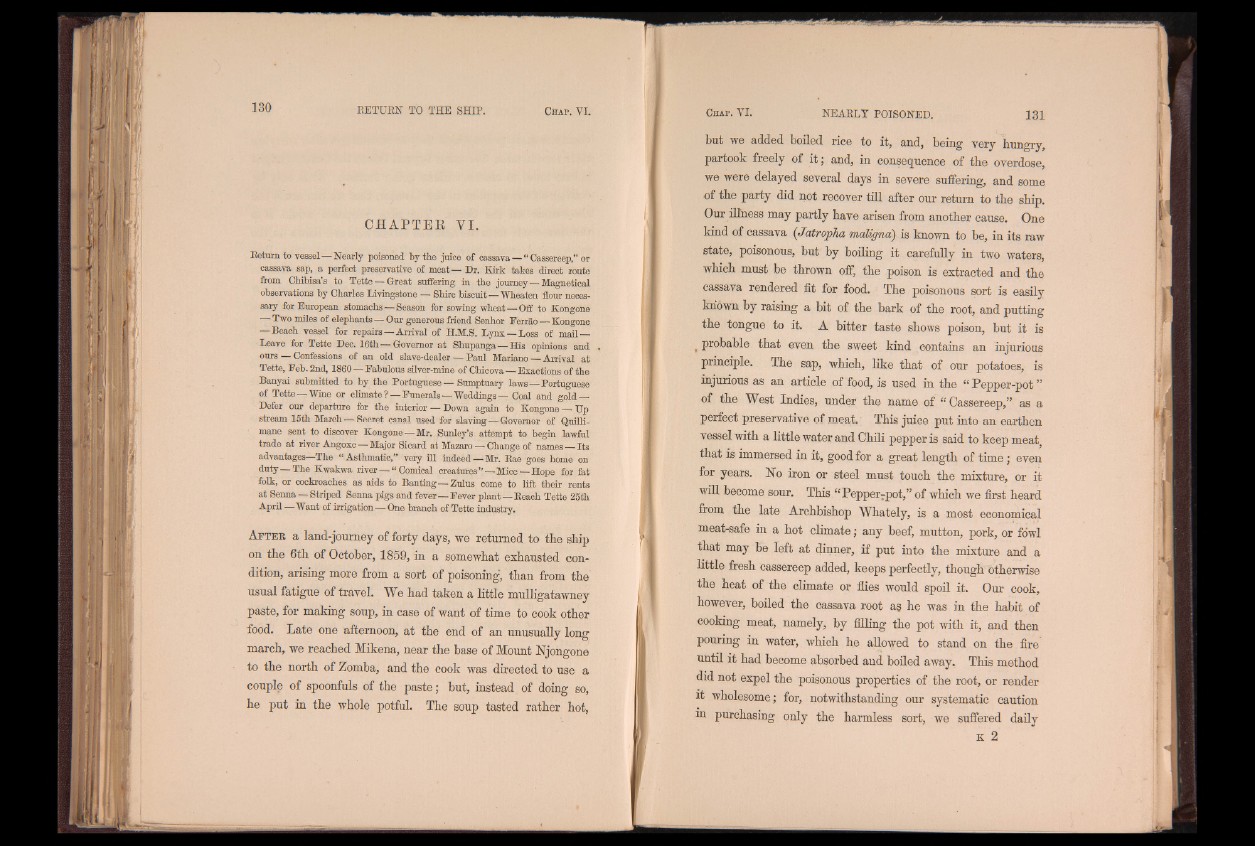
C H A P T E R Y I.
Return to vessel—Nearly poisoned by the juice of cassava — “ Cassereep,” or
cassava sap, a perfect preservative of meat— Dr. Kirk takes direct route
from Chibisa’s to Tette — Great suffering in the journey—Magnetical
observations by Charles Livingstone — Shire biscuit—Wheaten flour necessary
for European stomachs — Season for sowing wheat s Off to Kongone
— Two miles of elephants — Our generous friend Senhor Ferrao — Kongone
— Beach vessel for repairs—Arrival of H.M.S. Lynx —Loss of mail —
Leave for Tette Dec. 16th — Governor at Shupanga — Hia opinions and
ours — Confessions of an old slave-dealer — Paul Mariano — Arrival at
Tette, Feb. 2nd, 1860 — Fabulous silver-mine of Chicova — Exactions of the
Banyai submitted to by the Portuguese.—■ Sumptuary laws—Portuguese
of Tette—Wine or climate? —Funerals—Weddings— Coal and gold —
Defer our departure for the interior -—- Down again to Kongone — Up
stream 15th March—Secret canal used for slaving—Governor of Quilli-
mane sent to discover Kongone —Mr. S im le y ’s attempt to begin lawful
trade at river Angoxe—Major Sicard at Mazaro-—-Change of names — Its
advantages The “ Asthmatic,” very ill indeed — Mr. Rae goes home on
duty—The Kwakwa river — “ Comical creatures”—Mice—Hope for fat
folk, or cockroaches as aids to Banting—Zulus come to lift their rents
at Senna —Striped Senna pigs and fever—Fever plant—Reach Tette 25th
April —Want of irrigation—One branch of Tette industry.
A f t e r a land-joumey of forty days, we returned to the ship
on the 6th of October, 1859, in a somewhat exhausted condition,
arising more from a sort of poisoning, than from the
usual fatigue of travel. We had taken a little mulligatawney
paste, for making soup, in case of want of time to cook other
food. Late one afternoon, at the end of an unusually long
march, we reached Mikena, near the base of Mount Njongone
to the north of Zomba, and the cook was directed to use a
couple of spoonfuls of the paste; hut, instead of doing so,
he put in the whole potful. The soup tasted rather hot,
but we added boiled rice to it, and, being very hungry,
partook freely of it; and, in consequence of the overdose,
we were delayed several days in severe suffering, and some
of the party did not recover till after our return to the ship.
Our illness may partly have arisen from another cause. One
kind of cassava (Jatropha maligna) is known to be, in its raw
state, poisonous, but by boiling it carefully in two waters,
which must be thrown off, the poison is extracted and the
cassava rendered fit for food. The poisonous sort is easily
known by raising a bit of the bark of the root, and putting
the tongue to it. A bitter taste shows poison, but it is
> probable that even the sweet bind contains an injurious
principle. The sap, which, like that of our potatoes, is
injurious as an article of food, is used in the “ Pepper-pot”
of the West Indies, under the name of “ Cassereep,” as a
perfect preservative of meat,; This juice put into an earthen
vessel with a little water and Chili pepper is said to keep meat
that is immersed in it, good for a great length of time; even
for years. No iron or steel must touch the mixture, or it
will become sour. This “Pepper7pot,” of which we first heard
from the late Archbishop Whately, is a most economical
meat-safe in a hot climate; any beef, mutton, pork, or fowl
that may be left at dinner, if put into the mixture and a
little fresh cassereep added, keeps perfectly, though otherwise
the heat of the climate or flies would spoil it. Our cook,
however, boiled the cassava root a§ he was in the habit of
cooking meat, namely, by filling the pot with it, and then
pouring in water, which he allowed to stand on the fire
until it had become absorbed and boiled away. This method
did not expel the poisonous properties of the root, or render
it wholesome; for, notwithstanding our systematic caution
in purchasing only the harmless sort, we suffered daily
k 2